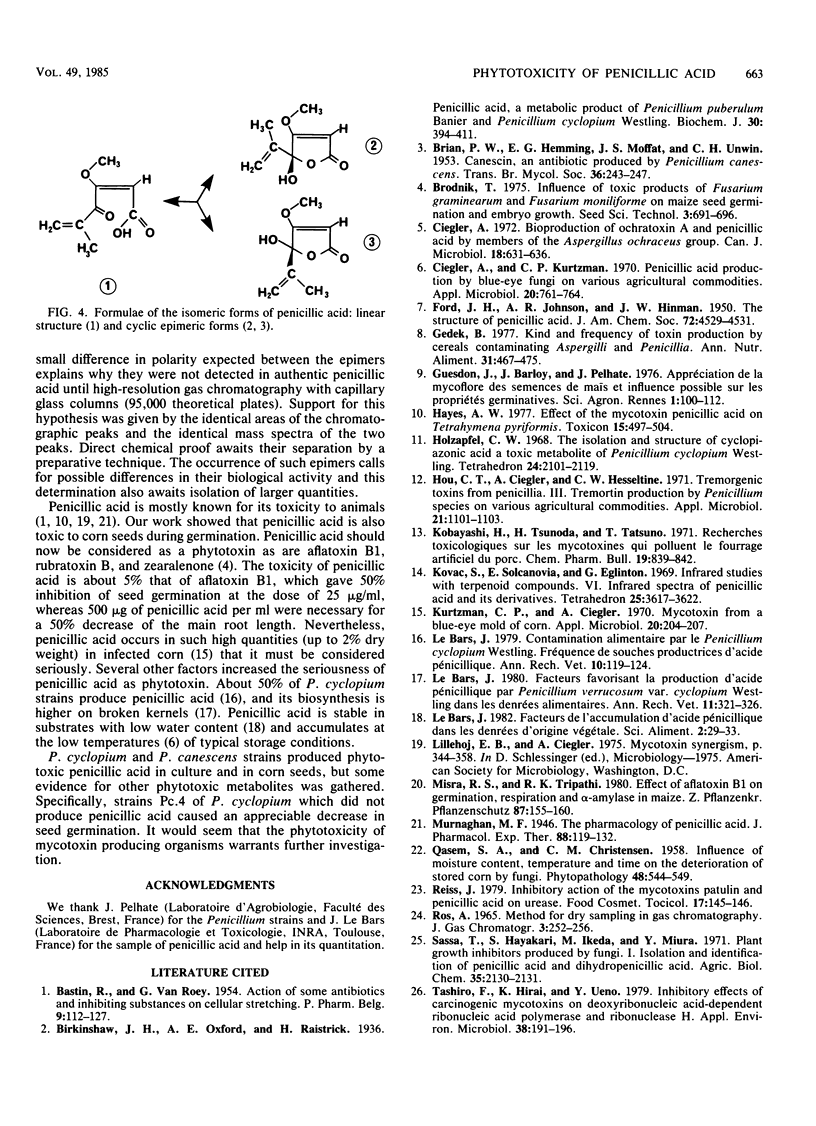Abstract
Penicillium cyclopium and Penicillium canescens cultures inhibited the germination of corn. The phytotoxic compound was isolated by solvent extraction and thin-layer chromatography on silica gel. The phytotoxin was identified as penicillic acid by mass spectrometry, nuclear magnetic resonance, and infrared spectroscopy. Gas-liquid chromatography on a capillary glass column separated the two epimeric forms of penicillic acid. The maximum production of penicillic acid was obtained with P. cyclopium cultures grown at 25°C. The phytotoxicity of penicillic acid was manifested by its ability to alter the germination of corn. The percent inhibition of germination was directly proportional to the logarithm of the penicillic acid concentration. Growth of the main root was reduced 50% by concentrations of 500 μg/ml.
Full text
PDF



Images in this article
Selected References
These references are in PubMed. This may not be the complete list of references from this article.
- Birkinshaw J. H., Oxford A. E., Raistrick H. Studies in the biochemistry of micro-organisms: Penicillic acid, a metabolic product of Penicillium puberulum Bainier and P. cylopium Westling. Biochem J. 1936 Mar;30(3):394–411. doi: 10.1042/bj0300394. [DOI] [PMC free article] [PubMed] [Google Scholar]
- Ciegler A. Bioproduction of ochratoxin A and penicillic acid by members of the Aspergillus ochraceus group. Can J Microbiol. 1972 May;18(5):631–636. doi: 10.1139/m72-100. [DOI] [PubMed] [Google Scholar]
- Ciegler A., Kurtzman C. P. Penicillic acid production by blue-eye fungi on various agricultural commodities. Appl Microbiol. 1970 Nov;20(5):761–764. doi: 10.1128/am.20.5.761-764.1970. [DOI] [PMC free article] [PubMed] [Google Scholar]
- Gedek B. Kind and frequency of toxin production by cereals contaminating Aspergilli and Penicillia. Ann Nutr Aliment. 1977;31(4-6):467–475. [PubMed] [Google Scholar]
- Hayes A. W. Effect of the mycotoxin, penicillic acid, on Tetrahymena pyriformis. Toxicon. 1977;15(6):497–504. doi: 10.1016/0041-0101(77)90100-3. [DOI] [PubMed] [Google Scholar]
- Holzapfel C. W. The isolation and structure of cyclopiazonic acid, a toxic metabolite of Penicillium cyclopium Westling. Tetrahedron. 1968 Mar;24(5):2101–2119. doi: 10.1016/0040-4020(68)88113-x. [DOI] [PubMed] [Google Scholar]
- Hou C. T., Ciegler A., Hesseltine C. W. Tremorgenic toxins from penicillia. 3. Tremortin production by Penicillium species on various agricultural commodities. Appl Microbiol. 1971 Jun;21(6):1101–1103. doi: 10.1128/am.21.6.1101-1103.1971. [DOI] [PMC free article] [PubMed] [Google Scholar]
- Kurtzman C. P., Ciegler A. Mycotoxin from a blue-eye mold of corn. Appl Microbiol. 1970 Aug;20(2):204–207. doi: 10.1128/am.20.2.204-207.1970. [DOI] [PMC free article] [PubMed] [Google Scholar]
- Le Bars J. Contamination alimentaire par le Penicillium cyclopium Westling. Fréquence de souches productrices d'acide pénicillique. Ann Rech Vet. 1979;10(1):119–124. [PubMed] [Google Scholar]
- Le Bars J. Facteurs favorisant la production d'acide pénicillique par Penicillium verrucosum var. cyclopium dans les denrées alimentaires. Ann Rech Vet. 1980;11(3):321–326. [PubMed] [Google Scholar]
- Reiss J. Inhibitory action of the mycotoxins patulin and penicillic acid on urease. Food Cosmet Toxicol. 1979 Apr;17(2):145–146. doi: 10.1016/0015-6264(79)90213-x. [DOI] [PubMed] [Google Scholar]
- Tashiro F., Hiral K., Ueno Y. Inhibitory effects of carcinogenic mycotoxins on deoxyribonucleic acid-dependent ribonucleic acid polymerase and ribonuclease H. Appl Environ Microbiol. 1979 Aug;38(2):191–196. doi: 10.1128/aem.38.2.191-196.1979. [DOI] [PMC free article] [PubMed] [Google Scholar]



